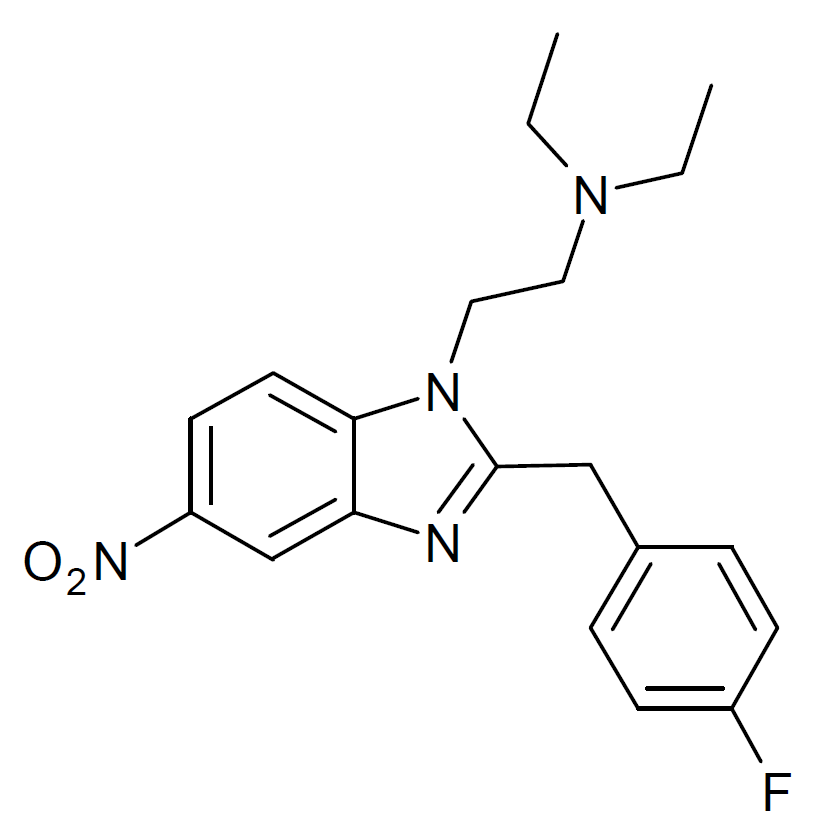Summary
Flunitazene, also known as Fluonitazene, is a benzimidazole-derived compound recognized for its opioid properties. It was initially formulated in the 1950s as part of the scientific exploration that eventually yielded more widely recognized substances like etonitazene. Despite being one of the less potent derivatives in its class, having roughly equivalent potency to morphine, Flunitazene has been illicitly available since around 2020 and has been associated with a significant number of drug overdose incidents.
| Identifiers | |
|---|---|
| IUPAC name | |
| CAS Number | 2249-36-7 |
|---|---|
| PubChem CID | 156588967 |
| UNII | LQS4YF6P6L |
| Chemical and physical data | |
| Formula | C20H23FN4O2 |
| Molar mass | 370.428 g·mol−1 |

FAQ
1. What is Flunitazene?
Flunitazene, also known as Fluonitazene, is a benzimidazole-derived compound known for its opioid effects.
2. Is Flunitazene legal?
The legal status of Flunitazene can vary by country and region. It is often sold as a designer drug, which may mean it’s not regulated and could be illegal in some places.
3. What are the effects of Flunitazene?
Flunitazene is reported to produce opioid effects, including pain relief and sedation. It has a potency similar to morphine.
4. Is Flunitazene safe to use?
No, Flunitazene is not safe to use. It has been associated with numerous cases of drug overdose and can be dangerous, even fatal when consumed.
5. How is Flunitazene typically consumed?
Flunitazene is often ingested orally, but it can also be used through other routes like snorting or injecting, which can further increase its risks.
6. What are the potential health risks of using Flunitazene?
Using Flunitazene poses significant health risks, including overdose, respiratory depression, addiction, and even death. It is crucial to be aware of these risks.
7. Can Flunitazene be detected in drug tests?
The ability to detect Flunitazene in drug tests may vary depending on the specific test. It’s important to note that drug tests can differ in what substances they screen for.
8. Is Flunitazene addictive?
Yes, like other opioids, Flunitazene can be highly addictive. Repeated use can lead to physical and psychological dependence.
9. Where can I find more information about Flunitazene and its risks?
Seek information from reputable sources such as government health agencies, addiction treatment centres, or substance abuse hotlines. It’s advisable to consult with a healthcare professional if you have concerns about Flunitazene or its effects.
10. How does Flunitazene compare to other opioids in terms of potency and effects?
Flunitazene is considered less potent than some other opioids but still poses substantial risks. It has similar potency to morphine, which is a widely recognized opioid. However, it can still lead to overdose and other health issues, making it dangerous for recreational use.
References
1. Lamy FR, Daniulaityte R, Barratt MJ, Lokala U, Sheth A, Carlson RG (August 2021). “Novel Synthetic Opioid Listings on the Darknet: “Etazene, safer than heroin and fentanyl”.” The study was published in Drug and Alcohol Dependence, Volume 225, Page 108790. DOI: 10.1016/j.drugalcdep.2021.108790. PMID: 34091156. S2CID: 235362241.
2. “A review of the evidence on the use and harms of 2-benzyl benzimidazole (‘nitazene’) and piperidine benzimidazolone (‘brorphine-like’) opioids” [PDF]. Published by the UK Advisory Council on the Misuse of Drugs in July 2022.
3. Walton SE, Krotulski AJ, Logan BK (March 2022). “Addressing New Synthetic Opioid Analogs: Liquid Chromatography-Tandem Quadrupole Mass Spectrometry (LC-QQQ-MS) Approach.” Published in the Journal of Analytical Toxicology, Volume 46, Issue 3, Pages 221–231. DOI: 10.1093/jat/bkab117. PMC: 8935987. PMID: 34792157.
4. Montanari E, Madeo G, Pichini S, Busardò FP, Carlier J (August 2022). “Systematic Review of Intoxications and Fatalities Related to Benzimidazole Opioids (Nitazene Analogs).” Published in Therapeutic Drug Monitoring, Volume 44, Issue 4, Pages 494–510. DOI: 10.1097/FTD.0000000000000970. PMID: 35149665. S2CID: 246776288.
5. Schüller M, Lucic I, Leere Øiestad ÅM, Pedersen-Bjergaard S, Øiestad EL (September 2023). “High-throughput Quantification of Emerging Nitazene Benzimidazole Opioid Analogs.” Published in the Journal of Analytical Toxicology. DOI: 10.1093/jat/bkad071. PMID: 37700512.
6. Balcaen M, Ventura M, Gil C, Luf A, Martins D, Cunha M, et al. (March 2023). “Strengthening the Analysis of New Psychoactive Substances: Challenges in Drug Surveillance through Harmonizing Drug Checking Services in Proficiency Testing.” Published in the International Journal of Environmental Research and Public Health, Volume 20, Issue 5, Page 4628. DOI: 10.3390/ijerph20054628. PMC: 10002093. PMID: 36901637.